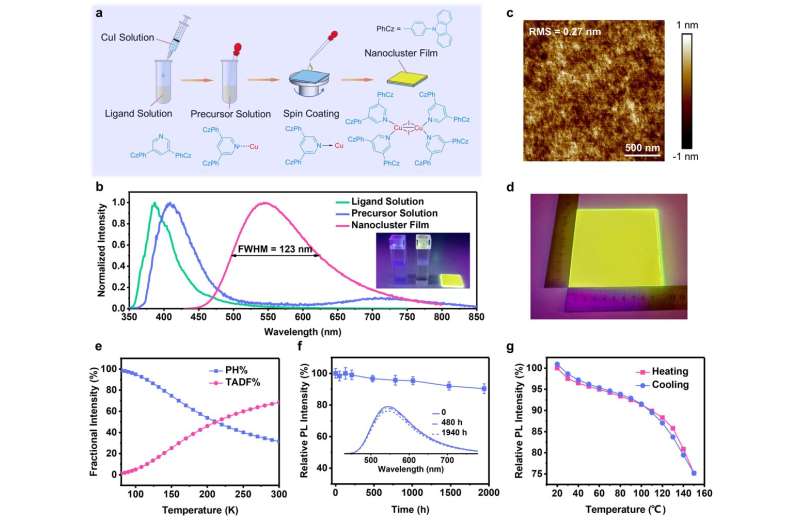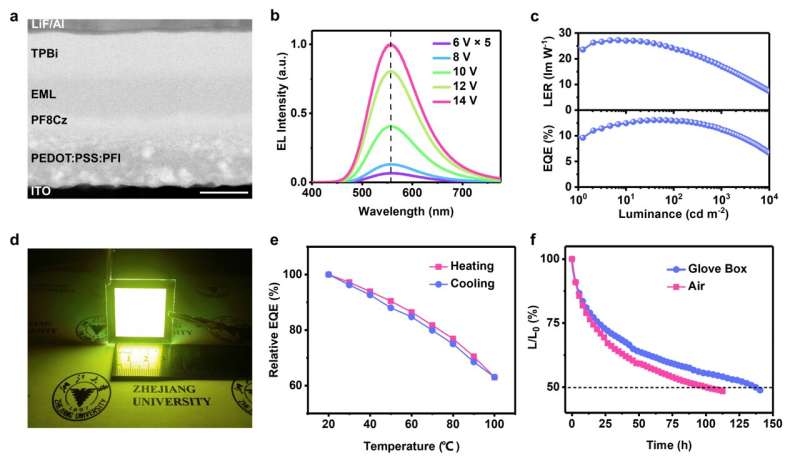This article has been reviewed according to Science X's editorial process and policies. Editors have highlighted the following attributes while ensuring the content's credibility:
fact-checked
peer-reviewed publication
proofread
Copper iodide nanoclusters offer environment-friendly solution for healthy lighting

Healthy lighting technology is receiving increasingly widespread attention. Traditional solid-state lighting sources utilize photoluminescence down conversion technology to realize ideal white emission. Specifically, yellow phosphors are excited by blue LEDs, or three-primary-color phosphors are excited by ultraviolet LEDs.
This strategy inevitably incorporates intense blue-violet components within the emission, which are harmful to the human body. Moreover, discrepant degradation rates of the emitters lead to instability of the emission spectra, and rare-earth metals (e.g., Y, Ce) or toxic metals (e.g., Cd, Pb) are always used in the phosphors.
Therefore, developing electroluminescent devices with ultrabroad and spectra-stable emission based on environment-friendly emitters is of importance for future healthy lighting, yet remains an unprecedented challenge.
In a paper published in Light Science & Applications, a team of scientists, led by Professor Xingliang Dai and Professor Zhizhen Ye from State Key Laboratory of Silicon and Advanced Semiconductor Materials, School of Materials Science and Engineering, Zhejiang University, China, have developed a copper iodide nanocluster prepared by a one-step solution synthesis-deposition process.
Through design of ligand and selection of solvent, the as-prepared nanocluster film exhibits ultra-broadband emission, high luminescent efficiency (up to 60%), uniform and compact morphology, and excellent ambient and thermal stability.
Based on this novel material, broadband nanocluster LEDs fabricated by a convenient solution process show stable emission spectra under different voltages, high quantum efficiency (13%) and luminance (50,000 nits), long operating half-lifetime (137 h), and nearly identical performance in inert or air atmospheres.

The results highlight the potential of copper halide nanoclusters for next-generation healthy lighting. These scientists summarized the innovative aspects of their work. The authors write, "The novel material and devices we have developed are expected to be strong candidates for the next-generation healthy lighting technology.
"Compared to the mainstream lighting technology, they possess the following advantages: 1) the emission spectra omit intense blue light components, which are beneficial to human body; 2) copper iodide nanocluster plays the single broadband emitter to generate spectra-stable emission, thus avoiding the color shift caused by different degradation rates of multiple emitters in the traditional technology; 3) the nanocluster consists of copper iodide and organic ligands, making them environment-friendly and low-cost.
"Besides, the corresponding LEDs are fabricated by solution process, resulting in low production costs and ease of large-scale manufacture.
"Due to the high structural rigidity of the nanocluster in the excited state, our LEDs exhibit excellent environmental stability and thermal stability. In addition, the dual-mode emission consists of phosphorescence and thermal activated delayed fluorescence endows the LEDs decent efficiency roll-off, which ensures high efficiency at high luminance. These properties are also crucial for lighting applications.
"The superiority in the rigidity of nanoclusters combined with the earth-rich and environmentally-friendly nature of CuI manifests the bright prospect of CuI nanoclusters to achieve broadband LED for lighting. We anticipate that the device efficiency and operational stability of the CuI nanocluster-based LEDs can be further optimized through rational ligand design."
More information: Dingshuo Zhang et al, Efficient and bright broadband electroluminescence based on environment-friendly metal halide nanoclusters, Light: Science & Applications (2024). DOI: 10.1038/s41377-024-01427-z
Journal information: Light: Science & Applications
Provided by Zhejiang University


















